
The Quaker parrot or monk parakeet is known for their charming, comical personality and willingness to learn human speech. It’s a great choice for bird lovers who want all the fun of a big parrot in a smaller package. They are very popular pets, good for dedicated beginners, and adapt well to life in a “human herd” environment.
- Size: 27 to 28 cm.
- Origin: Argentina/South America.
Quakers Are Known by Several Names
This parrot has several names such as quaker parrots, quaker parakeets, monk parrots, or monk parakeets. And the scientific name of the species is Myiopsitta monachus.
Monk parakeets are amazing birds. They gather, in a small size, the equivalent of a gray for its ability to speak, a macaw for its energy, and an amazon for its temperament. They are intelligent, funny, playful, curious, very dynamic, and above all spectacular talkers.
Well some parents are ridiculously awesome and cute they’re not always like that and they’re off highlighting videos because they’re exceptional every parrot is an individual and they won’t necessarily be what you see in a video or read on a website or in a book parrots are intelligent and highly emotional animals their personalities can change over time or their mood can swing up and down daily or seasonally.
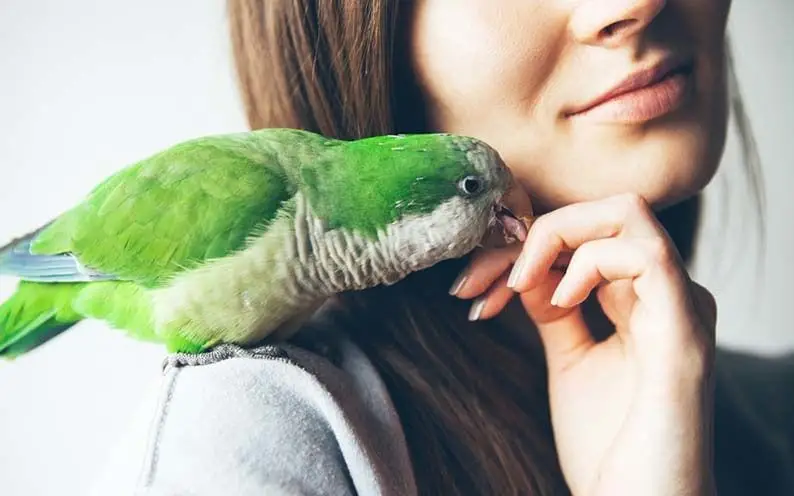
Quaker parrot personality
The Quaker parrot has an energetic personality!
We have the feeling that the quaker parrot always gets up on the right foot. In short, they have fishing, and sometimes too much! They are very popular in the United States, and many sites and books are dedicated to them. This shows the amazing power of attraction of these birds.
In any case, they make terrible (in every sense of the word) pet birds, guaranteed surprises.
Quaker Parrot Personality
A quick summary of quaker parrot natural instincts they are very vocal active social intelligent and territorial they live in huge flocks they built elaborate three-room nests and they defend their space valiantly
when you bring this spunky species into a human home it doesn’t change their instincts it just changes how these instinctual behaviors are presented they bond closely with their human they manipulate and destroy everything they can and protect their enclosure with everything they’ve got.
It means that Loki Monk Parakeet and I never have a dull moment in our interactions because he’s a unique representation of his species he’s very territorial of his enclosure it’s the fact that most people that have Quaker parrots have come to know
This means that I have to be aware that if I stick my bare hand in his enclosure he’s going to aggressively lunge at me and most likely bite.
I know being territorial comes with a package but for his mental and physical well-being he needs to come out and play so I’ve learned how to manage the situation in a positive way
I present a stick for him to step on – and when he lunges and bites the intruder he’s not doing any damage to me and I can safely get him out of his enclosure
His behavior
Mice parakeets are particularly active and curious. They will always find a place to discover in the house, a toy to disassemble, or a cage door to open. Their antics are incessant and that makes their charm. They are fairly independent birds capable of playing or chirping alone for hours.
They are often devoted and create quite strong bonds with their masters. Be careful, however, as these birds can become territorial, and their cage will become difficult to access. This behavior is to be anticipated with solid training. Especially since these little winged dragons are not afraid of much.
They are inveterate and love to plant their little beaks in pieces of wood. It is therefore better to give them branches rather than see the feet of a pretty dresser turned into dust.
Their voice in its natural state is particularly powerful, especially when the whole group starts vocalizing! On the other hand, hand-raised birds express themselves almost exclusively with language and sound borrowed from their environment. They can therefore chirp, sing, in short express themselves, without making them noisy birds.
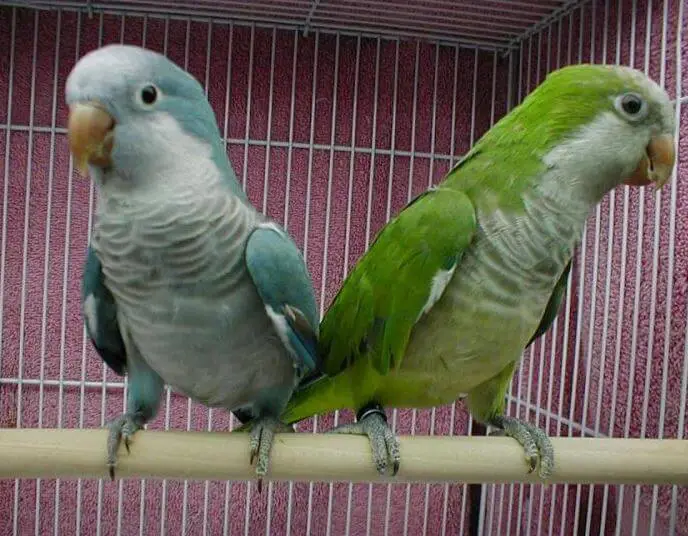
The Monk Parakeet is a very empathetic little parrot that reacts to all our moods, whether verbal or non-verbal. He is also very interactive and constantly wants to be part of the action. He is also very intelligent and can learn new things constantly.
On the other hand, he becomes easily anxious if his master is absent for too long a period of time and he does not like changes, so he is a little more difficult to adapt than other parrots. Also, it is necessary to educate it well, because it tends to take bad habits if it is not done properly.
Ability to speak
The real particularity of quaker parakeets is there: they are incredible talkers. They have an amazing ability to imitate human sounds and voices. Their voice is not as clear as that of a gray, an amazon, or an Eclectus, but it remains clear enough to be understood.
It is not uncommon to see them use the human voice during their first 6 months. Some breeders have found that young can talk even before weaning.
One of the most amazing aspects is the number of words they can acquire. Mattie Sue Athan conducted work on a “talker” sample of 55 quaker parakeets and she could see that they used an average of 15 words wisely! Some of them spoke with apparent understanding, at appropriate times. In the study group, the average age of acquisition of first words was 4 months.
The testimonials of owners of monk parakeets are generally edifying, and the situations described are striking.
Are Quaker Parrots Excellent Talkers?
The Monk Parakeet is a talking bird that must be trained in the most rigid way. When he is not properly educated, the Quaker Parrot adopts bad habits, pushing him to howl and also to chew. So let’s talk a little more about this very pretty bird
Can Quaker parrot sing? The Quaker is a good talker. He is the small parrot with the greatest language ability.
Its requirements
These antics tend to get bored faster than other species, and it is useful to provide them with many activities. Toys are especially important for monk parrots and should be changed frequently. If this is not the case, he will quickly get into the habit, to keep busy, of screaming or tearing off his feathers. On the other hand, to anticipate their tendency to become territorial, dressage and training sessions are necessary, from an early age.
The feeding of the quaker parakeet
Mice parakeets are very hardy, and feeding them is absolutely no problem. A mixture of seeds, granules, fruits, and vegetables will be more than enough. These active birds like to be fed 2 times a day, it keeps them busy.
The ideal family
The more active the family, the more your quaker parrot will flourish. This insatiable pitter will take advantage of the actions of family members. They are exceptional birds, easy (if well-bred), and really surprising. No particular constraint on the cage, apartment or house size, or feeding. Be careful, however, with your language, it could reproduce a few words. Inconsiderate.

Overview
| Quaker (Monk) Parrot Myopsitta monachus |
| Size: 30 cm / 12 inches in length |
| Weight: 90 to 150 grams (avg. 110 to 120) |
| Pet Status: Excellent |
| Talking Ability: Excellent |
| Noise Level: Low – Moderate |
| Lifespan: 25-30 years |
| Breeding Ability: Excellent |
| Number of Eggs: 4-8 eggs |
| Incubation: 24-28 days |
| Compatibility with other species: Not Advised |
| Feeding: Seed and Fruit Eaters |
| Sexing: DNA or Surgical sexing is required. Females are generally larger than males. |
Quaker parrot food
Grain mix for conure, feed (tropican), pasta, rice, brown bread
vegetables: spinach, broccoli, cucumber, squash, broad bean, alfalfa
fruits: apricot, banana, melon, peach, pear, grapes.
Extra cost
Supplement of concentrated vitamins, minerals, and amino acids (Premium).
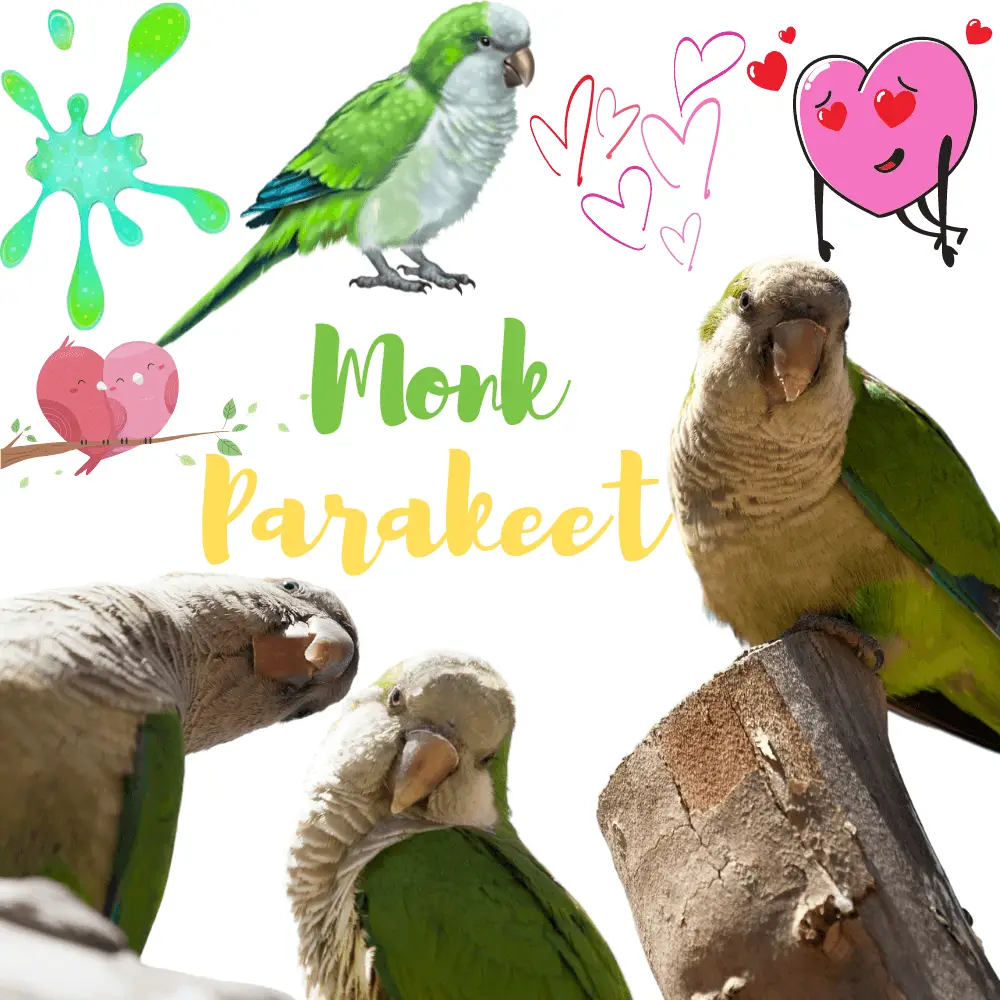
Quaker parrot care
The cage should be large enough for him to flap his wings and play comfortably. The spacing of the bars must not allow the bird to pass its head. Preferably, a rectangular cage is chosen.
Install the cage in a corner (if possible) and away from cold drafts. A daily shower and 10-12 hours of uninterrupted sleep are also recommended. It requires a size of claws and wings (if desired) every 2 months. Like all birds, it requires a cuttlebone to get the calcium it needs.
Parsley, beet greens, raw potatoes, avocados, cooked onions, seeds, pits, alcohol, caffeine, sugar (chocolate), salt, spices, Teflon, lead, mercury, zinc, household products (Swiffer, Glade plugged into the wall, etc. .), incense, scented candles, nicotine.
Parrot need
- A cage of at least 29” x 24” x 30”
- A cuttlebone
- Millets
- Food
- Toys
- A mineral block
- Substrate (wood pellets)
- Perches of different materials
- A vitamin and amino acid supplement
- A bath
Can Quaker Parrots Live for a Very Long Time
Quaker Parrot Lifespan: The lifespan of a quaker parrot: is 20 to 30 years old.
If given proper care throughout its life, a Quaker parrot can live 20 to 30 years in captivity. Some people can live even longer.
The monk parakeet colors and mutation
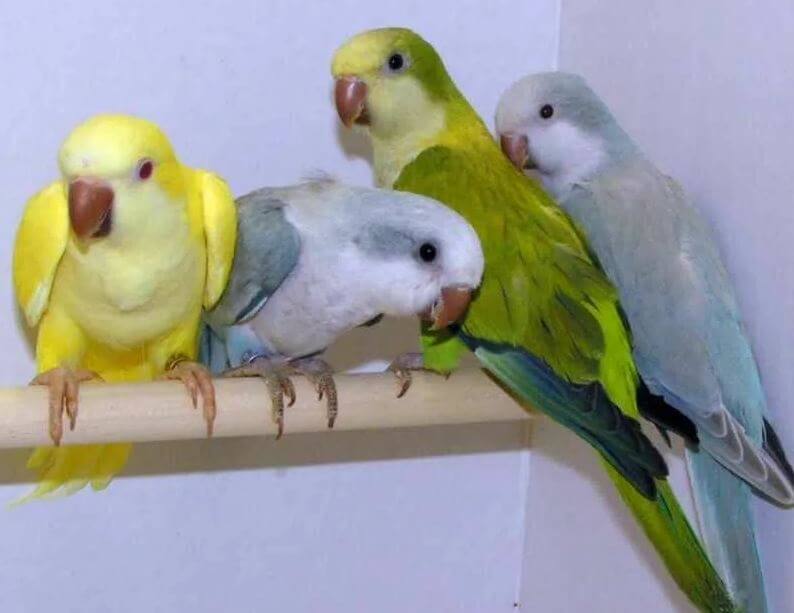
The normal colors of an adult Monk Parakeet are bright green on the head, wings, and back. The gray chest, cheeks, and throat are the distinctive features of the bird.
They have gorgeous blue feathers and a paler green tint on the underside of their tail. Their beak is horn-colored and their feet are gray. Overall they look like a stalky cockatiels.
Captive breeding programs have also produced a variety of beautiful color mutations in Quakers. One of the most popular is the blue Quaker hybrid parrot developed in the early 2000s. Breeders have also created albino, cinnamon, lutino, and piqué Quakers.
Men and women look alike. As with all species of monomorphic birds, the only way to know for sure the sex of your bird is through DNA sexing or surgery.
Monk parakeet Reproduction
Quakers are sexually mature at 24 to 36 months of age and weaning occurs between 6 and 8 weeks. The incubation period is 26 to 28 days and it can have 4 to 6 eggs per litter.
Quaker Parrot Nest
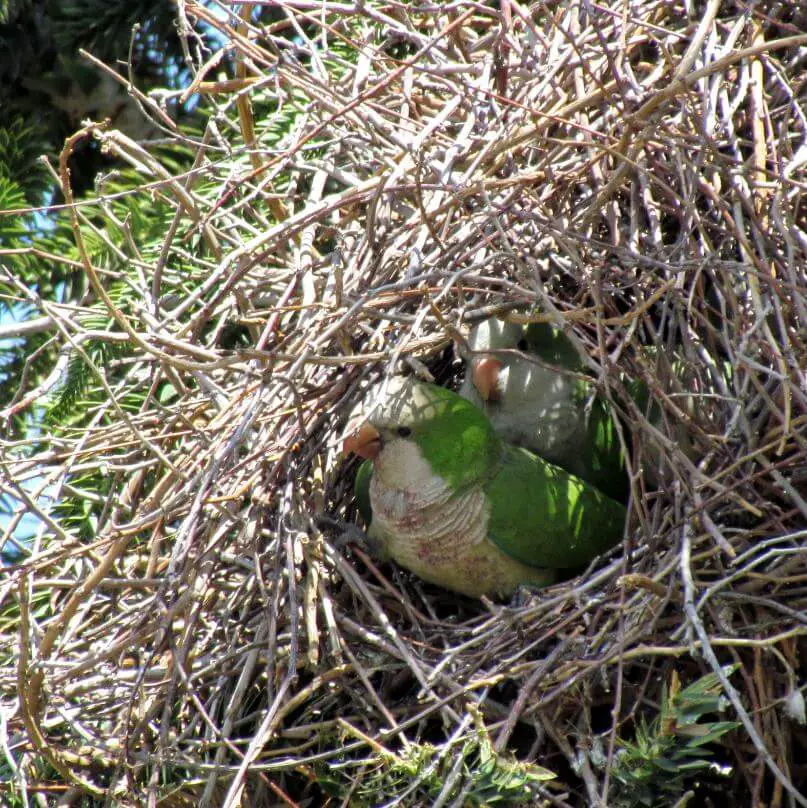
The most interesting habit of wild Quakers is that they are the only parrot to have built nests. While other species will find cavities in their trees, these birds will spend a lot of time creating elaborate dwellings out of twigs and branches.
Their nests even have multiple rooms, one for the eggs and another where the young chicks will move around to make room for more eggs.
Herds of Quakers often build nests next to each other. Each mated couple has their own dwelling, but shares walls with their neighbors to create what is now called “Quaker condominiums” or “Quaker apartments”. Some have reached around 200 pounds and are the size of a compact car.
Baby Monk parakeet

Quaker children do nothing less than shake their whole little bodies when feeding their parents or groomers. The behavior of the quaker is very different from what can be observed in other parrots. A person who is not used to being around this species may think that the bird is seriously ill.
Are Quaker Parrots Good pets
A few months ago Loki Quaker Parrot couldn’t get enough of our time together he was so vocal and he worked endlessly to perfect three new phrases we laughed together non-stop and he readily took seeds from my hand,
now he’s extraterritorial he hates other people and he’ll actively harass their hand like a competitive sport if I have a visitor over he’ll work really hard and put on a show flirting with me while they watch but if I try and interact with them he’ll lunge at me as well.
once he’s out he’s been biting me if I don’t let him do everything he wants to do but even though he’s being a bit of a booger lately ♥ I still love him ♥ because he’s being Loki Monk Parakeet and I’m okay with that and that’s what it takes to be a good pair of companion unconditional love.
My void is the reality of having a parrot as a companion isn’t always what it looks like from the outside it’s often a challenge to care for an animal that isn’t the perfect picture you had in your mind
The videos of Loki Quaker Parrot being adorable are true but here’s another truth he can be kind of a jerk sometimes and personally I think this makes him even more awesome so here’s the Loki Quaker Parrot is a multi-dimensional character and here’s to all of you who share your lives with Dynamic animals and love them for who they are.
If you’d like to go on an adventure with us every week share African-Parrot articles if you have a question for me throughout the week you can find them on Twitter Tumblr and Facebook thanks, guys.




















